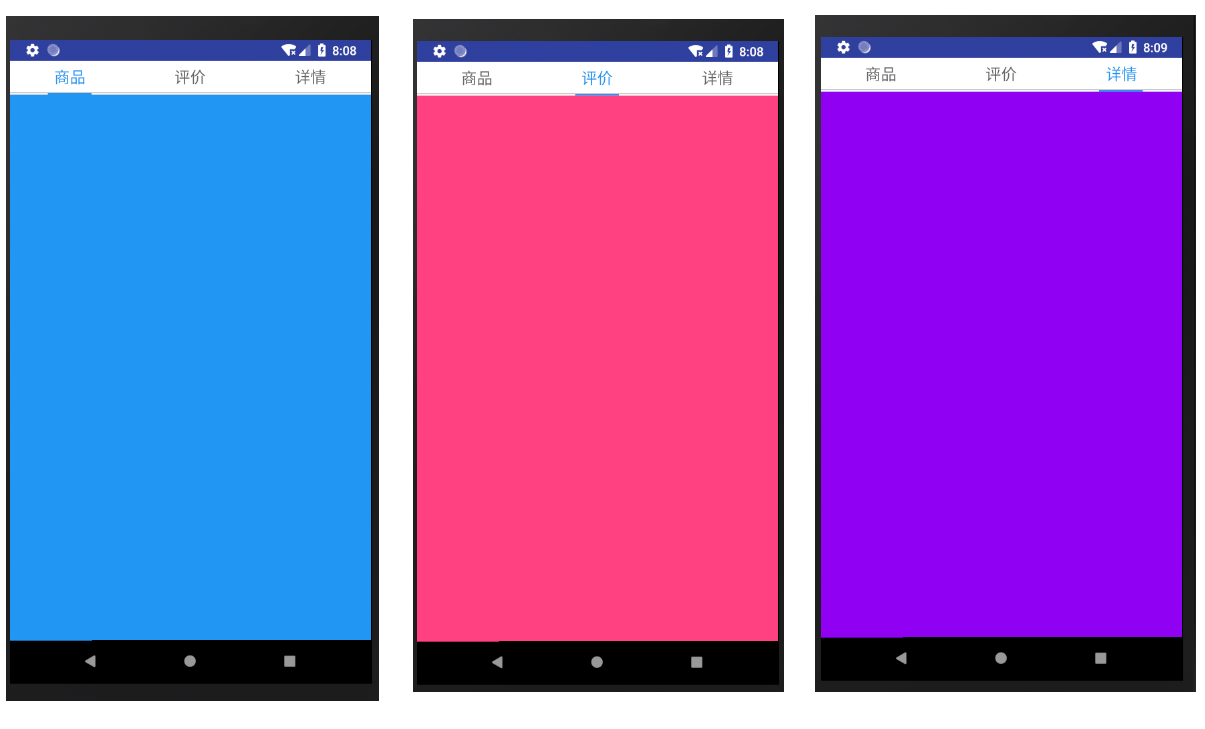本文实例为大家分享了android实现选项卡功能,通过计算偏移量,设置tetxview和imageView的对应值,一些color的值读者自己去补充
实现效果图:

(1)简单写一个主界面的布局activity_main.xml
<?xml version="1.0" encoding="utf-8"?><LinearLayout xmlns:android="http://schemas.android.com/apk/res/android" android:orientation="vertical" android:layout_width="match_parent" android:layout_height="match_parent" android:clipToPadding="true" android:fitsSystemWindows="true" android:background="@color/bg_color"> <LinearLayout android:layout_width="match_parent" android:layout_height="match_parent" android:background="@color/bag_gray" android:orientation="vertical"> <LinearLayout android:layout_width="match_parent" android:layout_height="36dp" android:background="@android:color/white" android:orientation="horizontal" android:weightSum="3"> <TextView android:id="@+id/tab1_tv" android:layout_width="0dp" android:layout_height="wrap_content" android:layout_gravity="center" android:layout_weight="1" android:gravity="center" android:text="商品" android:textColor="@color/title_bag" android:textSize="18sp" /> <TextView android:id="@+id/tab2_tv" android:layout_width="0dp" android:layout_height="wrap_content" android:layout_gravity="center" android:layout_weight="1" android:gravity="center" android:text="评价" android:textColor="@color/text_color_context" android:textSize="18sp" /> <TextView android:id="@+id/tab3_tv" android:layout_width="0dp" android:layout_height="wrap_content" android:layout_gravity="center" android:layout_weight="1" android:gravity="center" android:text="详情" android:textColor="@color/text_color_context" android:textSize="18sp" /> </LinearLayout> <View android:layout_width="match_parent" android:layout_height="0.5dp" android:background="@color/text_color_context" /> <View android:id="@+id/cursor" android:layout_width="50dp" android:layout_height="2dp" android:layout_marginLeft="40dp" android:layout_marginTop="0dip" android:background="@color/title_bag" /> <android.support.v4.view.ViewPager android:id="@+id/thire_vp" android:layout_width="match_parent" android:layout_height="match_parent"/> </LinearLayout></LinearLayout>
(2)设置viewpager的适配器:FragmentAdapter
public class FragmentAdapter extends FragmentPagerAdapter { private ArrayList<Fragment> list; FragmentManager fm; public FragmentAdapter(FragmentManager fm, ArrayList<Fragment> list){ super(fm); this.fm = fm; this.list = list; } @Override public Fragment getItem(int position) { return list.get(position); } @Override public int getCount() { return list.size(); }} (3)然后设置三个fragment,因为有三个选项卡,所以我们新建三个fragment,分别是OneFragment、TwoFragment 、ThreeFragment ,布局的话也需要新建三个,跟fragment一一对应,因为布局过于简单,这里就不写了,简单写一点fragment的代码吧
public class OneFragment extends Fragment { @Nullable @Override public View onCreateView(LayoutInflater inflater, @Nullable ViewGroup container, @Nullable Bundle savedInstanceState) { View view = inflater.inflate(R.layout.fragment_one,null); return view; }} (4)在MainActivity中,设置fragment的适配器,设置显示内容,并且做viewpager的事件监听
public class MainActivity extends FragmentActivity implements ViewPager.OnPageChangeListener,View.OnClickListener{ private TextView tab1Tv; private TextView tab2Tv; private TextView tab3Tv; private View cursor; private ViewPager thirdVp; private ArrayList<Fragment> fragmentlist; private int offset = 0; private int screenWidth = 0; private int screenl_3; private LinearLayout.LayoutParams lp; @Override protected void onCreate(@Nullable Bundle savedInstanceState) { super.onCreate(savedInstanceState); setContentView(R.layout.activity_product); //绑定控件 tab1Tv = (TextView)findViewById(R.id.tab1_tv); tab2Tv = (TextView)findViewById(R.id.tab2_tv); tab3Tv = (TextView)findViewById(R.id.tab3_tv); cursor = (View) findViewById(R.id.cursor); thirdVp = (ViewPager) findViewById(R.id.thire_vp); //获取屏幕宽度 DisplayMetrics dm = new DisplayMetrics(); getWindowManager().getDefaultDisplay().getMetrics(dm); screenWidth = dm.widthPixels; screenl_3 = screenWidth/3; //裁剪3分之1 lp = (LinearLayout.LayoutParams)cursor.getLayoutParams(); fragmentlist = new ArrayList<>(); fragmentlist.add(new OneFragment()); fragmentlist.add(new TwoFragment()); fragmentlist.add(new ThreeFragment()); thirdVp.setAdapter(new FragmentAdapter(getSupportFragmentManager(),fragmentlist)); thirdVp.setCurrentItem(0); thirdVp.setOffscreenPageLimit(2); thirdVp.setOnPageChangeListener(this); tab1Tv.setOnClickListener(this); tab2Tv.setOnClickListener(this); tab3Tv.setOnClickListener(this); } @Override public void onPageScrolled(int position, float positionOffset, int positionOffsetPixels) { offset = (screenl_3-cursor.getLayoutParams().width)/2; Log.d("TAG", "111----"+position + "--" + positionOffset + "--" + positionOffsetPixels); final float scale = getResources().getDisplayMetrics().density; if (position == 0){ lp.leftMargin = (int)(positionOffsetPixels/3)+offset; }else if(position ==1){ lp.leftMargin = (int)(positionOffsetPixels/3)+screenl_3+offset; } cursor.setLayoutParams(lp); upTextcolor(position); } private void upTextcolor(int position){ if (position==0){ tab1Tv.setTextColor(getResources().getColor(R.color.title_bag)); tab2Tv.setTextColor(getResources().getColor(R.color.text_color_context)); tab3Tv.setTextColor(getResources().getColor(R.color.text_color_context)); }else if(position==1){ tab1Tv.setTextColor(getResources().getColor(R.color.text_color_context)); tab2Tv.setTextColor(getResources().getColor(R.color.title_bag)); tab3Tv.setTextColor(getResources().getColor(R.color.text_color_context)); }else if(position==2){ tab1Tv.setTextColor(getResources().getColor(R.color.text_color_context)); tab2Tv.setTextColor(getResources().getColor(R.color.text_color_context)); tab3Tv.setTextColor(getResources().getColor(R.color.title_bag)); } } @Override public void onPageSelected(int position) { } @Override public void onPageScrollStateChanged(int state) { } @Override public void onClick(View view) { switch (view.getId()) { case R.id.tab1_tv: thirdVp.setCurrentItem(0); break; case R.id.tab2_tv: thirdVp.setCurrentItem(1); break; case R.id.tab3_tv: thirdVp.setCurrentItem(2); break; } }} 以上就是本文的全部内容,希望对大家的学习有所帮助,也希望大家多多支持VEVB武林网。
注:相关教程知识阅读请移步到Android开发频道。